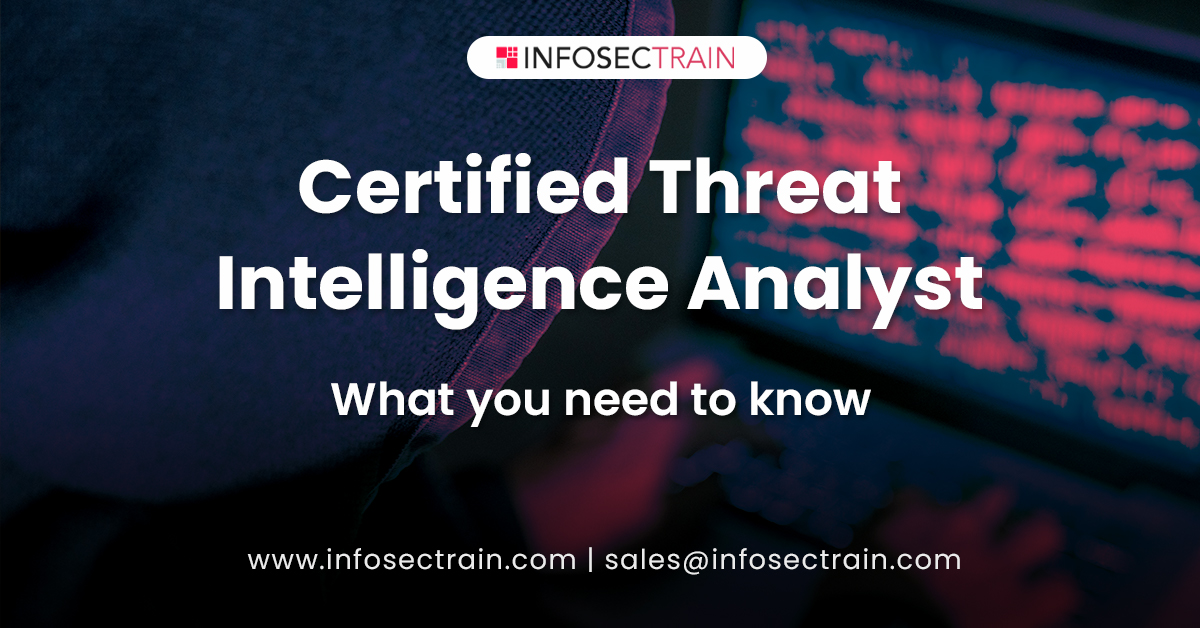Certified Threat Intelligence Analyst (CTIA): What you need to know
Some organizations have the resources and capabilities to secure their IT infrastructure against potential Cyber threats; however, many organizations cannot do so. Organizations either deploy the most up-to-date security software solution or pay thousands of dollars for security tools. Even after that, no organization is entirely secure. Organizations must be aware of modern-day threats and vulnerabilities to keep themselves protected from cyberattacks. These challenges can be overcome by working on a robust cyber threat intelligence program.

Certified Threat Intelligence Analyst (C|TIA) training enables cybersecurity professionals to improve their skills in building sufficient organizational cyber threat intelligence. Cyber threat intelligence involves reliable data collection from various sources, context-relevant analysis, production of useful intelligence, and distributing the relevant information to stakeholders. A threat intelligence analyst should have specific skills and knowledge to effectively understand modern attackers’ methodology to deploy the threat intelligence accordingly.
Why C|TIA?
‘Certified Threat Intelligence Analyst’ training program is intended and developed in collaboration with cybersecurity and threat intelligence experts worldwide to support organizations in identifying and mitigating business risks by transforming unknown internal and external threats into known threats. It is a complete specialist-level program that develops a structured approach for building sufficient threat intelligence. CTIA is one such examination that improves the individuals’ skills and prepares them well to make a useful threat intelligence in the organization. This program provides the reliable, professional knowledge needed for a career in threat intelligence and enhances your skills as a Threat Intelligence Analyst.
How is CTIA helping blue team Professional?
We have different teams in an organization, such as a red team, blue team, white team, and purple team.
- Red Team: The red teamers are the offensive players who hack into the organizations to find out the loopholes. A red team consists of cybersecurity professionals who act as adversaries to overcome cybersecurity controls. They utilize all the available technologies to find weaknesses in processes and technology to gain unauthorized access.
- Blue team: The blue teamers are the defensive players defending your organization against the red teaming activities. A blue team consists of security professionals who have an inside out view of the organization. Their task is to protect organizations’ critical assets against any threats.
- Purple team: It is a combination of red teamers and blue teamers. Purple teams are to assure and maximize the effectiveness of the Red and Blue teams. They do this by combining the defensive tactics and controls from the Blue Team with the threats and vulnerabilities found by the Red Team.
Threat intelligence useful for organizations of all shapes and sizes by helping process threat data to understand their attackers better, respond faster to the incidence, and proactively get ahead of a threat actor’s next move.
A threat profile is required to assess the security of an organization. A good threat profile includes examples of real-life threat instances and potential threat attackers. The profile shall define working on weak fronts to prepare for future attacks thoroughly.
By focusing on your organization’s most relevant cyber threats, you can mitigate these threats in advance. Without threat intelligence, your cybersecurity posture remains to be a reactive one, waiting for an incident, theft, or breach to work against it. Using threat intelligence, organizations can pinpoint their infrastructure’s weaknesses, which may be exploited in future cyberattacks, and remediate those weaknesses to close entry points for threat actors.
Why Do Organizations require a Threat Intelligence Team?
Malicious attacks are slowly going out, with new malware formed every four seconds. However, many organizations today still attend the basic, conventional methods to address these evolving techniques. Reacting to threats is much essential, but reacting also signifies that the damage is already done. Having a threat intelligence analyst will allow organizations to fight unexpected threats continually arising in the cyber world. An experienced threat intelligence analyst will gather large amounts of relevant threat information from data sources and detect the possible dangers that an organization may face.
What are the most common cyber threats?
The top 8 cyber threats are:
- Malware
- Phishing
- Password cracking
- DDoS
- Man in the middle
- Drive-by download
- Malvertising
- Rogue software
Cyber Threat Intelligence Life Cycle:
Planning : The first step is to determine your objectives that will increase your organization’s core values. It is necessary to understand how time-sensitive it is and what the result of the decision will be.
Collection: In the second step, the data is collected, as defined by the first stage’s requirements. The data can be internal data, such as previous incident history, or external, such as technical or dark web sources.
Processing: After collection in this step, we are organized and filtered for false and redundant information. In this phase, collected data passes through a variety of processes so that it can be useable for security procedures such as filter out as many false positives as you can, perform data correlation, translate languages, and aggregate data into suitable formats, etc.
Analysis: The analysis is a human process that applies processed information into intelligence that can inform decisions. Depending on the conditions, the decisions might involve investigating a potential threat and what actions to block an attack immediately.
Dissemination: This step involves sharing actionable intelligence with relevant stakeholders (internal as well as external stakeholders).
Objectives of C|TIA
- Complete threat analysis process includes threat modeling, fine-tuning, evaluation, runbook, and knowledge base creation.
- Different threat intelligence sharing platforms act and regulate sharing strategic, tactical, operational, and technical intelligence.
- Different types of cyber threats, their motives, goals, and objectives of cybersecurity attacks
- Cyber kill chain methodology, Advanced Persistent Threat (APT) lifecycle, Tactics, Techniques, and Procedures (TTP), Indicators of Compromise (IoCs), and pyramid of pain
How to prepare for the CTIA certification exam?
Following are the options available to prepare for the CTIA certification exam:
- Self-study resources: You can prepare for CTIA Certification by self-study resources, including books, videos, study guides, and practice questions.
- Video training: Videos helps in understanding difficult concepts. Studies show that video training is more effective in terms of retention as compared to traditional methods.
- Instructor-led Training: If you think self-study is not for you can use instructor-led training to prepare for the CTIA certification exam, you can learn directly from cybersecurity experts. The instructor-led training program allows you to get an in-depth understanding of every concept.
Certified Threat Intelligence Analyst training with Infosec Train
Infosec Train is one of the best IT Security training provider, focusing on a range of information security training programs and security consulting services. The CTIA training program at infosecTrain aims at providing in-depth knowledge on collecting useful threat intelligence and building robust cyber threat intelligence programs for the organizations. Our highly skilled Certified instructors, having years of industry experience, assist you in getting through the CTIA certification exam in the first attempt.
Check out and enroll yourself in our CTIA -certification-training to prepare for the certification exam.







 1800-843-7890 (India)
1800-843-7890 (India)